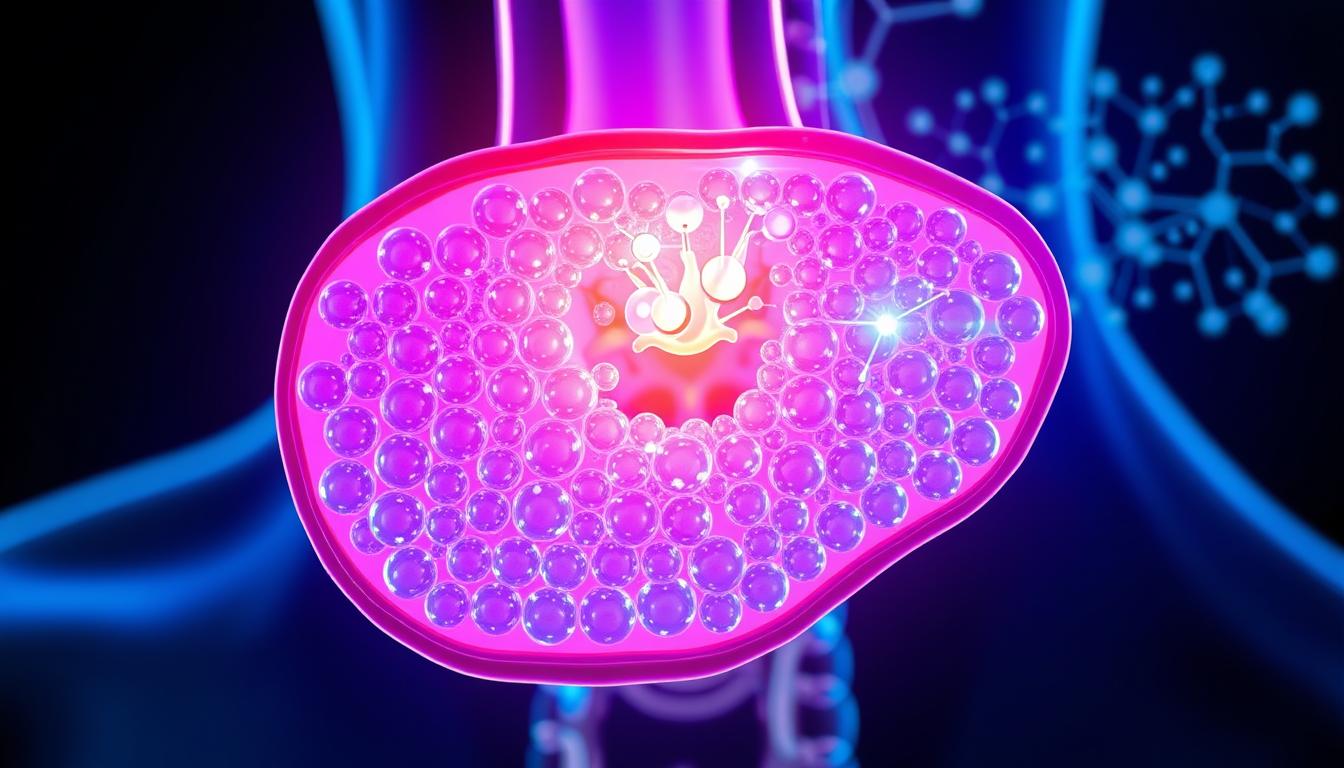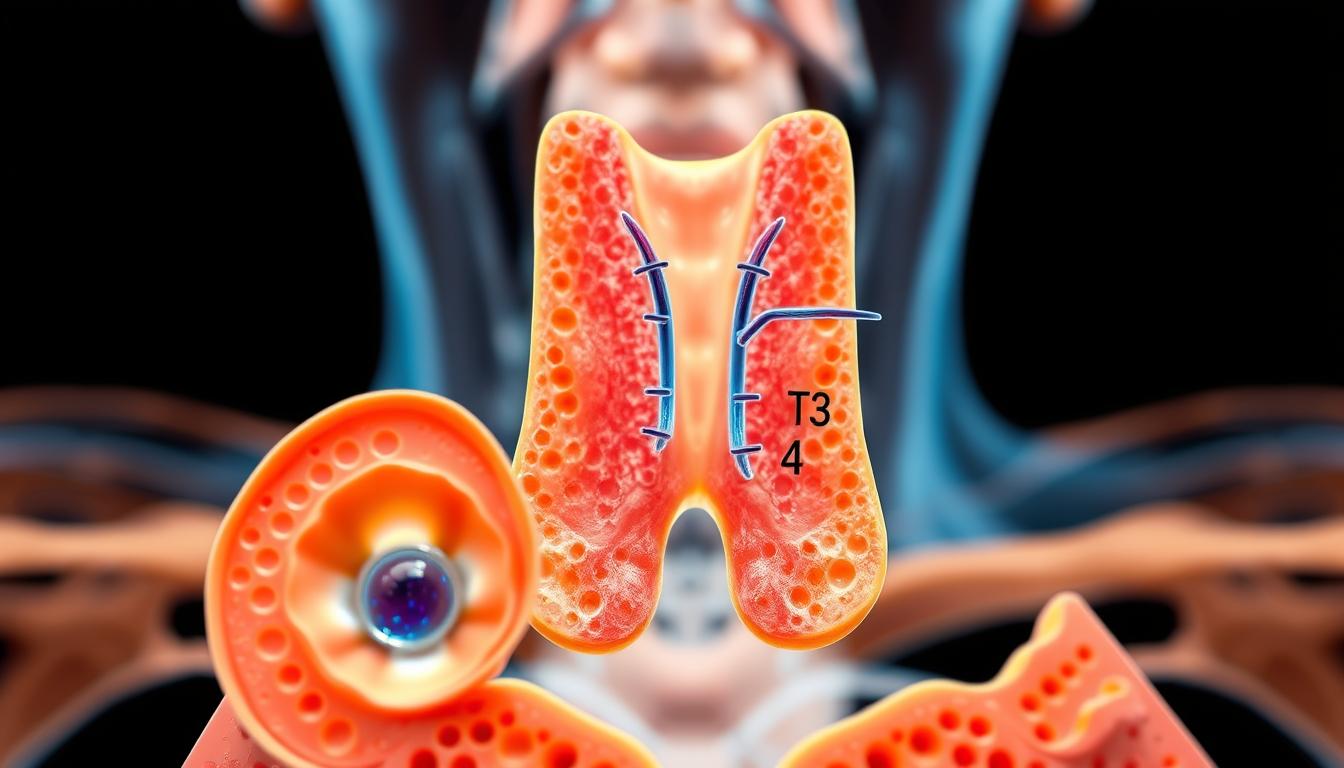Over 42% of Americans now use natural remedies to address chronic conditions – a trend driven by mounting interest in traditional healing practices. One botanical extract gaining attention targets a critical gland affecting 1 in 10 U.S. adults: the thyroid.
Derived from a mint-family plant used for centuries in Ayurvedic medicine, this compound activates cellular processes through a unique mechanism. By elevating cAMP levels – a messenger molecule regulating metabolism – it may influence hormone release patterns. Modern research continues exploring its effects on underactive glandular activity.
Many seek alternatives to conventional treatments for hormonal imbalances. While some studies suggest potential benefits, questions remain about long-term impacts. Understanding how traditional plant extracts interact with delicate biological systems requires examining both historical applications and contemporary science.
Key Takeaways
- Traditional herbal extracts are being reevaluated for modern hormonal support
- Cellular activation through cAMP pathways may influence glandular function
- Over 10% of U.S. adults experience thyroid-related challenges
- Historical medicinal practices inform current complementary approaches
- Balanced evaluation of natural remedies requires scientific scrutiny
Overview of Thyroid Health and Its Importance
Your body’s metabolic engine depends on a small butterfly-shaped organ in your neck. This gland acts as a control center, producing chemical messengers that influence nearly every bodily process. When functioning optimally, it helps maintain energy balance, temperature regulation, and cellular repair.

The Role of the Thyroid Gland in Your Body
The thyroid gland releases two primary hormones: T4 (thyroxine) and T3 (triiodothyronine). These compounds travel through your bloodstream, telling cells when to speed up or slow down their activities. Your heart rate, digestion, and even mood rely on their precise balance.
Three key organs work together to manage hormone production:
- Hypothalamus detects low hormone levels
- Pituitary gland releases TSH (thyroid-stimulating hormone)
- Thyroid responds by making T4 and small amounts of T3
How Thyroid Hormones Regulate Metabolism and Energy
Your thyroid hormones act like metabolic thermostats. T3—the active form—directly impacts how cells convert nutrients into energy. Nearly 90% of T4 gets converted into T3 in organs like your liver and kidneys through a process called deiodination.
| Hormone | Production Site | Activity Level |
|---|---|---|
| T4 | Thyroid | Low |
| T3 | Peripheral tissues | High |
This conversion system ensures your body can adjust energy output based on needs. When disrupted, you might experience fatigue, weight changes, or temperature sensitivity. Maintaining this delicate balance proves crucial for overall vitality.
Understanding Thyroid Disorders and Symptoms
Thyroid disorders silently reshape daily life, often masquerading as routine stress or aging. Nearly 1 in 8 women develop glandular issues during their lifetime, with autoimmune conditions accounting for most cases. Recognizing patterns helps separate temporary discomfort from chronic conditions needing medical attention.

Three Primary Conditions Explained
Hypothyroidism creeps in with persistent fatigue and unexpected weight gain. You might notice cold intolerance or brain fog disrupting work efficiency. Constipation and brittle nails often accompany these warning signs.
Hyperthyroidism accelerates bodily functions, creating opposite effects. Rapid heartbeat and excessive sweating occur alongside weight loss despite increased hunger. About 80% of cases stem from Graves’ disease, which can cause eye protrusion.
Hashimoto thyroiditis gradually destroys hormone production through autoimmune attacks. This condition accounts for 90% of underactive gland cases. Early detection prevents progression to severe hormone deficiency.
When Symptoms Disrupt Life
Untreated disorders cascade into systemic complications. Mild fatigue evolves into debilitating exhaustion, while mood swings strain relationships. Cognitive decline impacts job performance, and metabolic changes alter body composition.
| Condition | Key Symptoms | Common Triggers |
|---|---|---|
| Hypothyroidism | Weight gain, cold sensitivity | Autoimmune attack |
| Hyperthyroidism | Rapid pulse, heat intolerance | Graves’ disease |
| Hashimoto’s | Fatigue, hair thinning | Genetic predisposition |
Diagnostic blood tests measure TSH levels and antibodies. Women over 35 should consider annual screening, especially with family history. Early intervention prevents irreversible damage to vital organs.
Forskolin and Thyroid Health: Boost or Burnout?
What if a plant compound could jumpstart your body’s energy regulation system? Certain botanical extracts interact with cellular pathways that influence hormone production. This interaction occurs through specific enzyme activation processes.

Exploring the Mechanisms of Action
The primary biological pathway involves adenylate cyclase activation. This enzyme boosts cyclic AMP production – a cellular messenger that stimulates glandular activity. Research shows this process may enhance T3 and T4 release more effectively than natural triggers.
Laboratory studies comparing stimulation methods reveal significant differences:
| Stimulant | Response Time | Hormone Output |
|---|---|---|
| Natural TSH | 60-90 minutes | Baseline levels |
| Plant Extract | 15-30 minutes | 2-3x increase |
Potential Benefits and Considerations
Standard protocols suggest 50 mg doses twice daily for glandular support. This approach might help maintain hormonal balance without synthetic replacements. However, combining these supplements with prescription treatments requires medical guidance.
Current findings show promise in cellular models, but human trials remain limited. One 12-week study observed improved metabolic markers in 68% of participants. Always consult healthcare providers before modifying treatment plans, particularly with existing blood pressure or respiratory conditions.
Natural Supplements and Nutrients for Thyroid Support
Nutrition forms the foundation of glandular balance. Specific nutrients help maintain hormone production and protect against cellular stress. Three minerals and select herbs show particular promise for maintaining equilibrium.
Essential Micronutrients: Iodine, Selenium, and Magnesium
Iodine builds 65% of T4 hormones. Adults need 150 mcg daily through foods like seaweed or fortified salt. Deficiencies can disrupt your body’s energy regulation systems.
Selenium activates thyroid hormones while calming immune overactivity. A 200 mcg daily dose for 3-6 months helps manage antibody levels in autoimmune conditions. Brazil nuts provide natural sources.
Magnesium supports 300+ enzyme reactions affecting hormone conversion. Low levels correlate with higher rates of glandular dysfunction. Leafy greens and pumpkin seeds boost intake.
| Supplement | Key Benefit | Recommended Intake | Duration |
|---|---|---|---|
| Iodine | T4 hormone synthesis | 150 mcg/day | Ongoing |
| Selenium | Antibody reduction | 200 mcg/day | 3-6 months |
| Magnesium | Enzyme activation | 300-400 mg/day | Ongoing |
Herbal Remedies: Ashwagandha, Ginger, and Black Seed
Ginger improves TSH levels at 500 mg twice daily. Studies show reduced fatigue and weight changes after 30 days. Fresh roots or capsules deliver active compounds.
Black seed (Nigella sativa) lowers antibodies in autoimmune patients. Two grams daily for 8 weeks enhances T3 production. It also supports metabolic efficiency.
Ashwagandha balances cortisol while aiding T4 conversion. A 600 mg daily dose for 8 weeks improves multiple hormone markers. This adaptogen works best with consistent use.
How Forskolin Works to Enhance Thyroid Function
Cellular communication pathways hold surprising potential for metabolic regulation. Certain plant-derived compounds interact with biological systems through precise molecular mechanisms. This process begins at the enzyme level, triggering cascades that affect hormone production.
The cAMP Activation Pathway
When specific enzymes activate within glandular tissues, they spark a chain reaction. Adenylate cyclase stimulation elevates cyclic AMP levels – a key messenger directing cellular activity. Higher concentrations accelerate thyroid hormone release, potentially enhancing metabolic output.
Modern vs Conventional Approaches
Traditional treatments rely on external hormone replacement. Emerging research explores compounds that amplify your body’s natural production capacity. Early studies suggest these methods may achieve faster results than standard protocols while maintaining existing regulatory checks.
Understanding these mechanisms helps evaluate complementary support strategies. Always consult healthcare providers before adjusting management plans for glandular function. Personalized approaches yield optimal results for maintaining systemic balance.